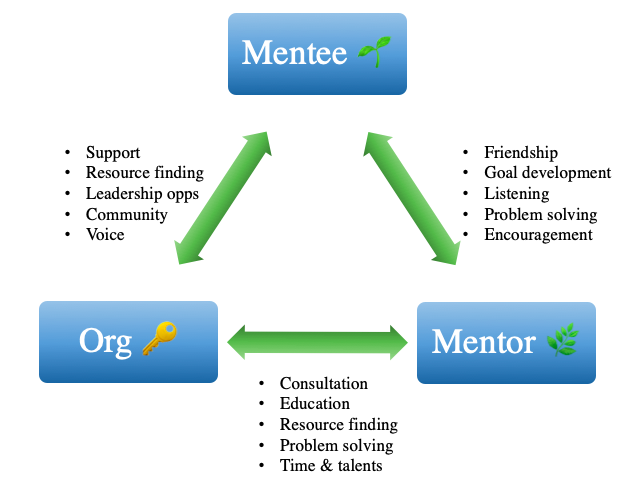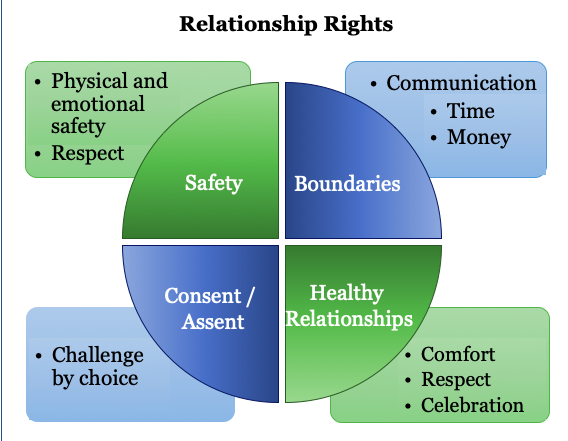Bringing mentees on board: A mini-guide
Every so often I find a golden nugget on Twitter that just makes sense. Here’s one from British-American author and inspirational speaker Simon Sinek:
A mentor is not someone who walks ahead of us to show us how they did it. A mentor walks alongside us to show us what we can do.
— Simon Sinek (@simonsinek) February 5, 2021
A good message is always clear and to the point. This one resonates because it’s how I personally define mentoring. It suggests that today’s world, support and scaffolding heavily outweigh prescription in mentoring relationships.
Just think of anyone who’s been a mentor in your life. Did they tell you exactly what to do, just as they did? Or did they show curiosity, encouragement, and resources that allowed to you forge your own path forward?

A good mentor asks challenging questions baked from care. They clarify our options and their implications. They celebrate strengths we don’t yet see. Someone I consider a mentor once pointed out that my experiences as a middle child prepared me to be an attuned and diplomatic leader. Though I never thought about that too deeply before, it became central to how I conceptualized my leadership style moving forward. Obviously we need more people like this in our lives.
When it comes to formal relationships, the language we use to pitch mentoring opportunities to young people is paramount. It could make the difference between actually wanting a mentor and feeling like someone is assigned to fix our lives (spoiler alert: not what we’re going for 🤦🏻♀️ ). The right language re-frames how mentees enter into a relationship and identifies their personal role in moving that relationship forward.
A question I often hear from mentoring organizations is this: How do you explain the concept of mentorship to prospective mentees? It’s not that easy when you think about it.
A good mentor asks challenging questions baked from care. They clarify our options and their implications. They celebrate strengths we don’t yet see.
Lots of organizations struggle to effectively communicate the purpose of their mentoring programs to youth. This is especially challenging when mentors are chosen by someone else in the mentee’s life, or when mentees simply haven’t perceived good treatment by other providers in the past. Maybe they had a negative experience with another mentor, and just don’t want to take that risk again. I wouldn’t blame them. In getting them back on board, each little step matters.
Here are some small but meaningful practices that in my experience, have helped mentees feel ready and excited to contribute to a mentoring relationship:
Leveraging onboarding
Let’s face it. A blurb or brochure doesn’t convey what your organization is really about. Taking real time to talk with mentees not only builds an initial connection with them – it creates space to flesh out questions and expectations for your program. Mentee onboarding (training/orientation/however you want to call it) is where this happens. Unfortunately many mentoring programs skip this step and miss a critical moment for buy-in.
What’s mentee onboarding? It’s an informal, 30-minuteor-less chat to review:

- The org and what you do
- The mentee’s role
- The mentor’s role
- Your role!
- Mentee rights, decision making, and confidentiality
- General rules and expectations
Overall the aim of this conversation is to avoid the one-way-helping relationship mentality, which may be off-putting to mentees who don’t want to be seen as clients, but rather as real players in the mentoring relationship. Let’s break some key parts down further:
The mentee role 🌱
From the start, it’s important to describe qualities of what it means to be a mentee and focus on agentic parts of their role such as:
- making decisions
- having good ideas
- being safe and respectful
- wanting a mentor to support (x,y,z) goals
- connecting to opportunities with your org
Always make sure to emphazise it’s a relationship mentees can opt into (program-dependent, of course). It revolves around what they want to get out of it, whether that be having a trusted adult friend, working on life skills, or just trying something new. If a mentee knows what they’re signing up for, they’re more likely to meet those expectations as they arise.
The mentor role 🌿
The key to explaining the concept of volunteer mentorship is reinforcing the fact that mentors want to be there, want to spend time with mentees, and want to learn more about them. Many mentees simply don’t believe that mentors don’t get some kind of payment, and so focusing on the fact that mentors have time, experience, and resources to share with others is helpful. If a mentor is paid (ex. therapeutic mentors), this may need further finessing, but people who become paid mentors also have the qualities of wanting to help and connect with others. Leverage this.
Some cool qualities to highlight about mentors include being:
- A trusted adult friend
- A good listener
- Non-judgmental
- Safe, respectful, and fun
- There because they want(!) to be there
- Ready to encourage and support with mentee’s (x,y,z) goals
Focus on the mentor’s interest and self-learning here, and less on what the mentee receives, because ultimately the mentee chooses what they get out of the relationship (again avoiding the one-way helping relationship mentality). It’s okay to consider that mentors, like everybody else, want connection and have chosen your organization as a cool place to find it.
Your role (a key step)! 🔑
Mentees need to visualize their role in the larger support team, as opposed to linear recipients of a service. Make sure to explain what you do, supports you provide, and the nature of your relationship to the mentee and mentor (together and separately). Be real, and be kind, because you want to make clear you’re someone to be trusted.
As shown below, each relationship is a two-way relationship, and so it’s important to let mentees know they’re an equally valued piece of the puzzle. It’s also a great starting point to talk about what communication looks like between all parties.

Rights, decisions, and confidentiality
This is a final piece is important to mention because it caters to the mentee’s agency and comfortability in starting a new relationship. Here lies the space to talk about what the program entails and what the relationship looks like in practice. Explore these in detail and offer time for questions so the mentee can better internalize your program.
Topics around decision making and confidentiality are similar. Talk with mentees about their decision making in choosing activities and clarify what it means to share confidential information with a mentor (aka, information needing to be passed on to you for safety concerns). Talking about these dynamics builds trust to help mentees feel more in the driver’s seat of their relationship.

Always keep conversations youth-focused and developmentally appropriate. Invite parents or caregivers into the conversation to build their understanding and gain even more buy-in. If you can help it, avoid terms like helping or serving. I like to use supporting and connecting to show that the mentoring relationship isn’t a one-way deal that just benefits mentors. Reiterating that mentors have a lot to learn from mentees is key, as is focusing on the goals of the relationship being driven by mentee interest.
A final word – obviously the policies and nuances of any mentoring program should be adapted to keep mentees at the center of the process. With so many alternative approaches to mentoring these days, the definition of mentoring is becoming more complex and deserves individualized and context-based decision making for each program.

There’s certainly something unique about mentoring relationships, compared to other developmental relationships, that brings about change we can’t always predict. Usually it involves some equation of social connection + learning, but whatever it yields, so much depends on those initial steps. If we can leverage mentee interest and belief in their own capacity to build a healthy relationship, we can take the equation to new levels. We can make space for more to be possible.
And at the end of the day, as Simon says, we want that mentor walking alongside us to help show us what we can do.